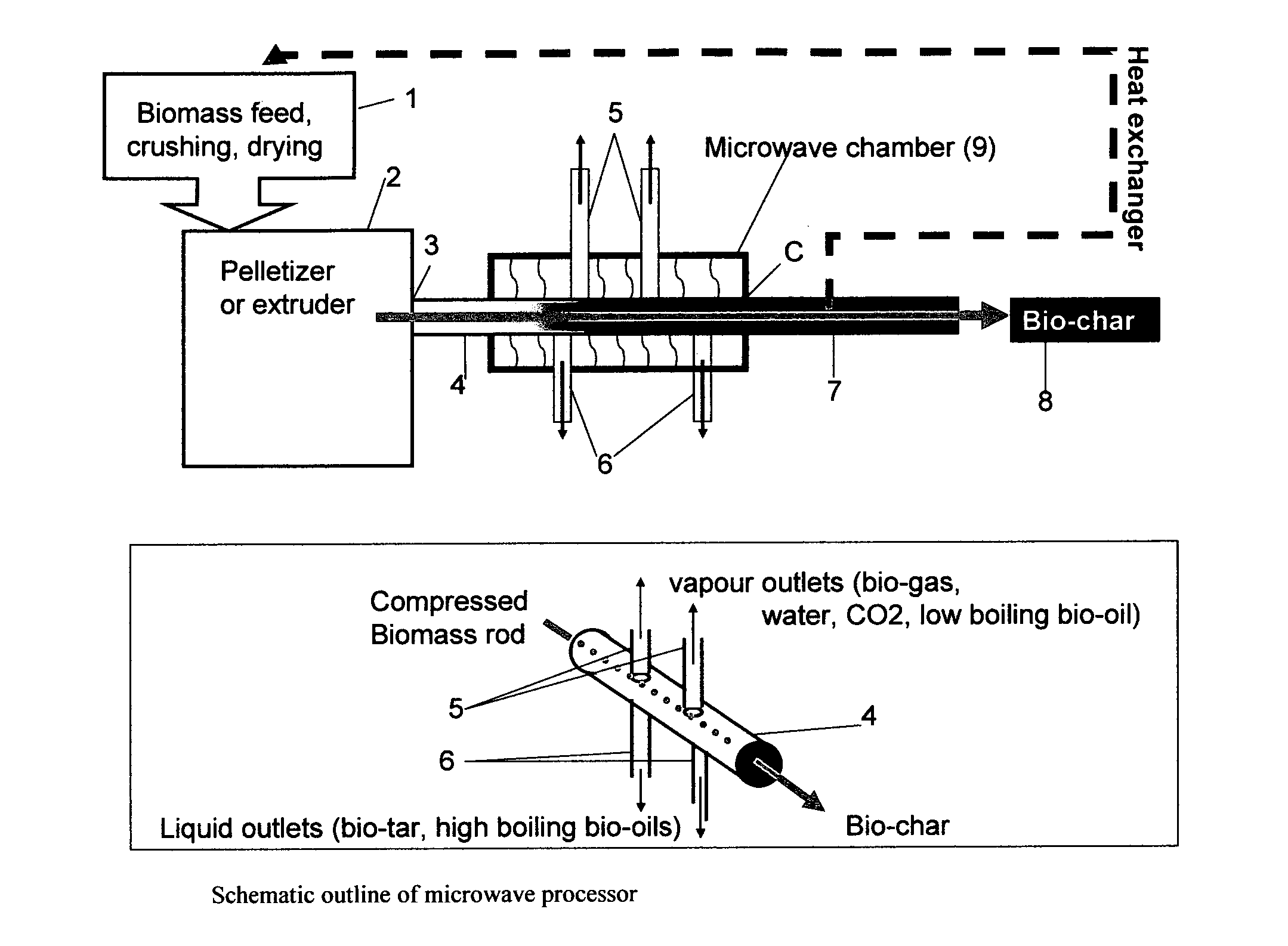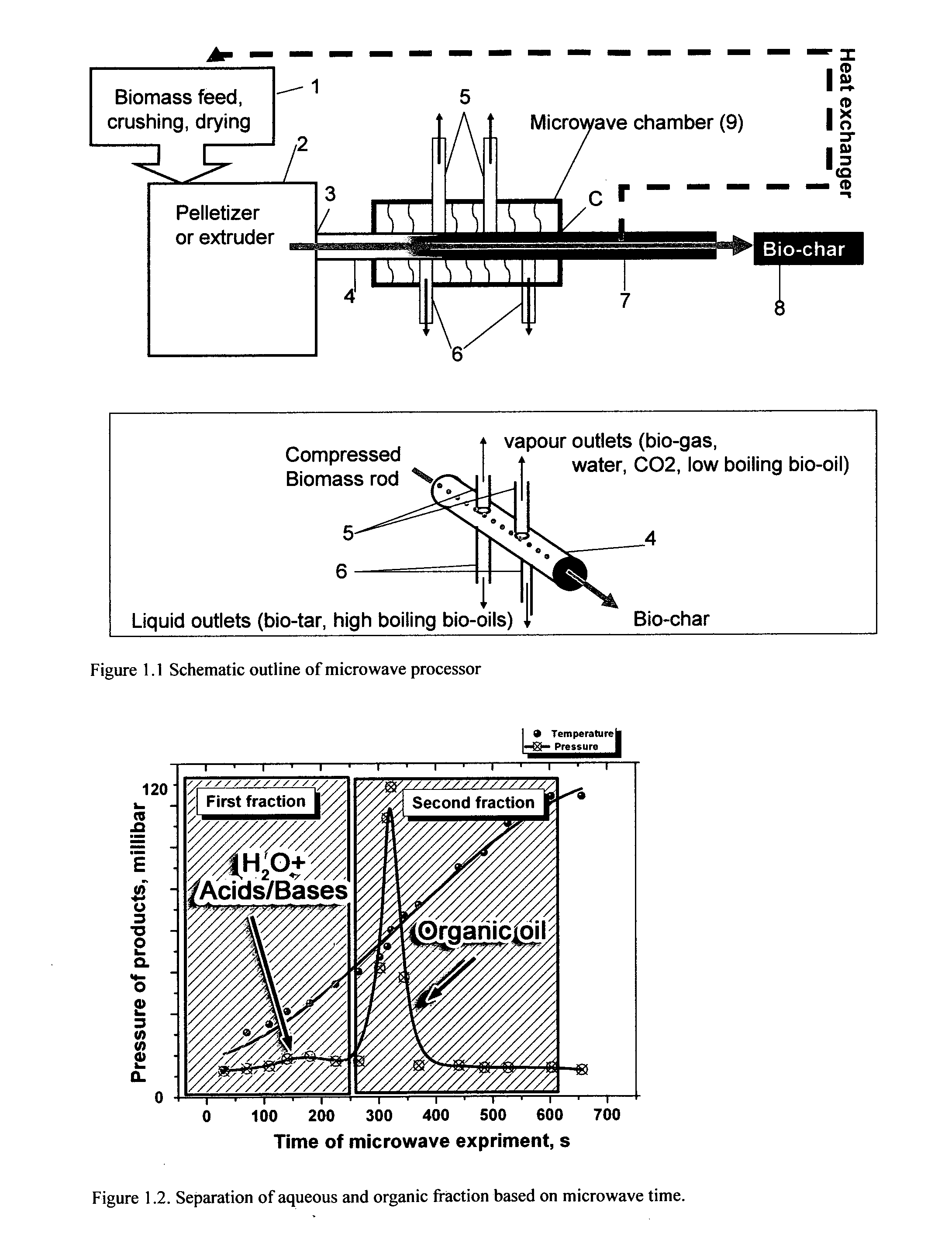Microwave torrefaction of biomass
a technology of biomass and microwave energy, applied in the field of biomass processing, to achieve the effect of reducing voids, enhancing flexibility and control of process, and maximising the absorption efficiency of microwave energy
- Summary
- Abstract
- Description
- Claims
- Application Information
AI Technical Summary
Benefits of technology
Problems solved by technology
Method used
Image
Examples
example 1.0
Influence of Microwave Time on Decomposition of Preheated Biomass Pellets Under Nitrogen Flow
[0211]Thermal decomposition of canary grass pellets under nitrogen atmosphere was carried out as shown in FIGS. 1.3 and 1.4. The apparatus included a microwave and IR gas cell for monitoring off gases.
[0212]5 g of canary grass pellets was preheated at 180° C. and placed inside CEM microwave. Microwave irradiation with power 300 W was applied to the sample during 6 minutes. The typical Gram-Schmidt profile (which was calculated as integral of IR gas spectrum) for organic volatiles is shown in FIG. 1.4. There are at least three stages during the period of microwave decomposition occurring sequentially in time:
1) removal of water with and low boiling aldehydes and acids;
2) removal of CO2 and CO accompanied by organic compounds; and
3) removal of compounds containing hydroxyl groups.
example 1
Influence of Biomass Density on Microwave Decomposition of Biomass
[0213]Number of biomass samples with different density were decomposed with microwave thermal treatment to chars. Energy absorbed by the samples was calculated. FIG. 1.5 shows influence of sample density on the energy efficiency of microwave decomposition.
example 2.1
Microwave Extraction of Primary Oil & Wax from Rape Meal in Water
[0214]The use of microwave radiation and water to extract the primary oil and wax extracts from rape meal was carried out using the following procedure.
[0215]Rape meal (4 g) and water (8 g) were weighed out into a round bottom flask with a magnetic stirrer. This mixture was then placed in a laboratory microwave in the open vessel settings. The typical parameters used in the microwave are: power 300 W; time: 1 to 15 minutes; stirring: ON; cooling: OFF.
[0216]To the round bottom flask containing the sample mixture a two-necked adapter was attached with one inlet allowing a supply of nitrogen to ensure no oxidation of the materials during the run and the second to allow a Dean-Stark apparatus to be attached with a condenser with cooling set to −10° C. to collect the primary extract. A second condenser with cooling to −60° C. (acetone / liquid nitrogen mixture) was attached, with a two-necked round bottom flask beneath. The c...
PUM
| Property | Measurement | Unit |
|---|---|---|
| Temperature | aaaaa | aaaaa |
| Temperature | aaaaa | aaaaa |
| Temperature | aaaaa | aaaaa |
Abstract
Description
Claims
Application Information
 Login to View More
Login to View More - R&D
- Intellectual Property
- Life Sciences
- Materials
- Tech Scout
- Unparalleled Data Quality
- Higher Quality Content
- 60% Fewer Hallucinations
Browse by: Latest US Patents, China's latest patents, Technical Efficacy Thesaurus, Application Domain, Technology Topic, Popular Technical Reports.
© 2025 PatSnap. All rights reserved.Legal|Privacy policy|Modern Slavery Act Transparency Statement|Sitemap|About US| Contact US: help@patsnap.com



